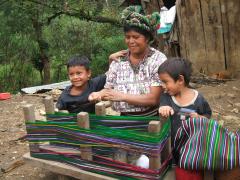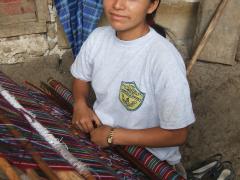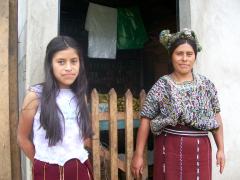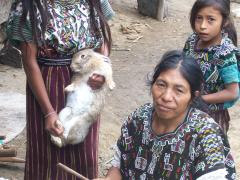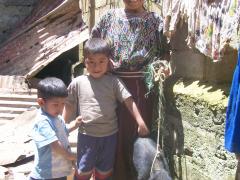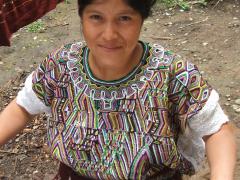Podcast: Friendship Bridge Women of Nebaj
We remember so very many women and have so many stories to tell from our time in Guatemala - we thought we'd just tell a few stories. Read on for lots of pictures and a slideshow of the women.
Maria Brito
To get to Maria Brito's house, we rode our bikes just up into the skirts of the valley where Nebaj is. As you leave the city (or town, really) you end up right away in green cornfields with people's houses scattered among them. Before long, you get to the end of the electricity lines, and well beyond the paved road, and end up on a muddy track headed up the hill. That's where Maria's house is. When we first met her, we thought "Oh, she's pretty poor" because she lived in a shack that she herself would not consider a house, with no electricity and with the water spigot across the road (at least she had one). But like many of the women we met, her dignity and friendliness transformed her right before our eyes from someone to be pitied into a woman to be honored, repected, and treasured.
The Nebaj region was devastated in Guatemala's civil war, which lasted from the 60's into the 90's. The worst part was during the mid-eighties, when many of the villages were destroyed completely as a part of the government's attempt to root out the guerrillas. Maria has not recovered from that time - she was the only member of her family left alive after the war, and she has not recovered economically either. In that time of confusion and pain she also got absolutely no education, can't read or write, and signs her name with a thumbprint. But, of course, when she signs her name she has no way to verify what she's signing.
Maria's business is weaving, and she demonstrated the setup of a weaving project by getting out her urdidor, the pegs that she uses to lay out a project. And she also bought some turkeys and pigs with her loan, so we asked to see them - and the kids herded the entire bunch right in front of us (and into the house, where they proceded to eat things they were not supposed to eat. Like most of the weavers we met, Maria spends her loan on yarn, then does her weaving and sells it. Before she had access to Friendship Bridge capital, she (like the others) rarely could get enough money together to buy the yarn.
Rosa Marcos
Rosa is only 17 but is of the new breed of Guatemalan women. She lives with her mother just a little ways from Maria Brito on a different muddy path, but she lives in a much better house, with electricity, and she has a full education. When we talked to her she had just ifnished her education as a biligual Spanish/Ixil elementary teacher, so by the time you read this she should be teaching in a remote village, making sure that the kids get the chance to read and understand the things that they can sign with a signature.
Rosa's significantly enhanced standard of living probably comes from many sources, but it's interesting to note that her two brothers are working in the United States and have sent what money they could home to finance the construction of a real concrete block house, with electricity and a metal roof. Migration of the young men has had some pretty significant impacts on the folks back home.
Maria Tipaz Ramirez
Maria Tipaz is another woman who carries on her life with strength and uprightness even though she's lacking some of the things that we consider so basic. She does weaving and has a little store, and uses her FB loan like so many other weavers and storekeepers - it's working capital. We were impressed with her ambition - the weaving had not really brought in enough income, so she started a little tiny store. But the thing that has confused Nancy every time she thinks of it is that Maria can't add or even use a calculator, because she never did go to school. So how does she handle adding up multiple purchases? We asked: She calls one of the kids to do it for her. Thankfully, the kids are getting the education that she missed.
The Village of Vijolom
One fine day we waited for the bus in the rain at 5:00am to go up to the village of Vijolom for an 8:00am group meeting. Vijolom seems so far from Nebaj, but it's still in the same region, with similar dress, including the cinta, the long woven cord that's wrapped into their hair and has little tassels on the end. Almost all the women here are doing one kind of agriculture of another - mostly raising a few sheep. One has a little store, and some weave, like Elena Brito, shown here with her daughters. One interesting note about Elena: she has two deaf daughters, and they have not learned to communicate except with an improvised set of gestures. There don't seem to be any services for deaf children, at least in the remote areas. We ran into another family with deaf children later on, and were struck with the idea that it might be more common than it ought to be.
Juana Corio
Juana was another of the dramatically affected children of the war years, and she, too, has not recovered. She lives in a little place right in the town of Nebaj - there's kind of a side door that you enter to get into the little space where she lives (somewhere) and raises a couple of pigs and some chickens and her two small children. We were pretty amazed at her energy and enthusiam in tackling the business of making a living. She explained to us how she gets her pigs to raise: Instead of riding the bus to the town where she buys them, she walks, starting really early in the morning so she can get there early enough on market day. She walks to avoid paying the bus fare on the way there, because she has to pay extra for the livestock (hoisted up on the top of the bus in baskets, of course) on the way back. So she spends a whole day on getting the pigs when she goes to buy them.
Raising livestock in the center of Nebaj is quite different from what one might expect in the developed world. There is very little grazing available. Almost all the land is reserved for growing crops like corn, carrots, beans, but mostly corn because it is the main food staple . In order to raise a cow or pig or goat, an animal is housed in a pen next to the house or in Juana's case, in the small downstairs outside storage area of her house . We meet women who take their animal out daily walks by attaching a rope as a leash and grazing them along the side of the road or any open space they can the side of the road. It's a way of taking advantage of whatever is out there.
Our visit with Juana helped us to understand something of the strength of the clothing culture of the Mayan women. When we arrived at her house, she seemed poor, maybe unkempt, and perhaps dirty - probably because we came unannounced and because she lives in a place with a dirt floor. But she went out with us to take us to the next client visit, and she seemed like a completely different woman. We wish we had a photo for you - she had her hairpiece in and her baby on her back, and another child holding her hand. She led us with such dignity to the next visit. Once she had her proper clothes on and was out in the world she seemed like a completely different woman.
Catarina Matom
Catarina impressed us again with her commitment to life and her family. As she demonstrated her weaving for us, her 9-year-old son went back and forth with buckets of concrete, helping with repairs and reconstruction on the house. She explained with great gravity her commitment to teaching the child to work around the home, and to keep him busy so that he wouldn't end up a delinquent out on the street.
Catarina's life demonstrated again one of the realities of Guatemalan life: medical intervention usually just doesn't happen. When she was just two, her mother left her unattended (as Catarina recounts with quite a lot of disapproval) and somehow she took a terrible fall. When they finally found her, unconcious, she had a horribly broken leg. Well, nothing was ever really done with it, and she just drags it around to this day. In the developed world, we'd expect at least something to have been done for that leg, but not in Guatemala. An injury of that type will haunt a person for life.
Click here for a slideshow of our favorite pictures of the women in Nebaj
- Artist: Hobobiker.com
- Title: Friendship Bridge Women of Nebaj
- Genre: podcast
- Year: 2007
- Length: 42:58 minutes (8 MB)
- Format: MP3 Mono 44kHz 128Kbps (CBR)

